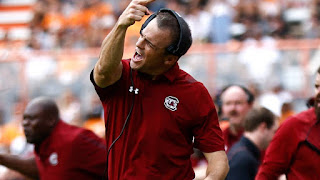Recruit rankings are fun to talk about, but they really don't matter
There has been a booming business over the last decade or two in the sports world. I'm not saying anything new or prophetic that recruiting has become a major niche coverage for sports junkies.
Truth be told, I dabbled in it during my time as a high school sports journalist, focusing mostly on athletes from the Anderson/Oconee/Pickens area of South Carolina.
Without question, the major eye-ball grabber was major college football recruiting. Not really surprising considering how college football focused the area, and the South in general, is.
For fans, it is a fun thing to keep up with and see which athletes your school is courting to help build for the future; which athletes are showing love on social media; how 'Player X' is the key cog to help take 'Team A' to the next level.
Many online-only sites have made this their bread and butter. A smart move on their part. I don't want to criticize what these hard-working men and women do. From experience, keeping up with the interests of 15-to-18-year olds -- and I mean no disrespect -- a tough gig.
You are either finding them on social media or scouring their highlight tapes for contact info, while also talking to their coaches, really anybody close to get that one nugget of info about where that player could be signing come December or February.
For the most part though, that aspect of covering recruiting can be fun, especially for a local journalist. It gives you a chance to build a great working relationship with that player, his coaches and that school and you can find some interesting stories that range from funny, to uplifting, to heart string-tugging.
But the other side of recruiting is the rankings system. Again, a hard job to build these ranked lists that take hours upon hours of work, and it should be commended.
These lists get athletes excited and gives them an idea of where they stand nationally. At least, that is what the national recruiting sites like you to think.
Athletes, I have news for you. College coaches don't look at those rankings and they don't put much stock into the combine results.
What college coaches, from the Power 5 programs in Division I, to your local Division II down the road or the Division III or NAIA programs you may just be hearing about, pay attention to is what your high school coaches say about you, your game film, your grades and how you perform at a program's prospect camp.
I will say, in the last 10 years the recruiting sites have gotten better at identifying the top prospects (it usually helps if they report to have offers from the top programs in the country) but in the end, the college coaches tend to know best you can cut it and who can't.
This goes for fans as well. It is easy to get caught up in stars and where one player ranks oppose to another, but in reality, the difference between a "3-star" guy and a "4-star" guy is minimal.
These rankings also don't always take into account scheme fit. Let me explain.
Say your favorite school runs a 4-3 defensive scheme, but the No. 1 DT prospect in your state, ranked No. 15 nationally, projects as a 3-4 noseguard while the No. 2 DT in your state, say ranked No. 18 nationally, fits your scheme.
Which do you think your program would be smartest to recruit?
The big picture here is this: Recruiting sites are just like any other fan site -- they do give relevant information at times, but in the end, it is about entertainment value and getting eyeballs on their product.
Rankings can be fun for players, and motivate some to try to "move up." But in the end recruiting is about college programs finding the best players available that fit the system they run. And they tend to know who the best players are.
And unless they are Alabama, Oklahoma, Clemson or Ohio State, they also tend to know quickly who they realistically have a shot at signing.



Comments
Post a Comment